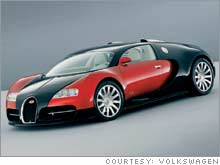|
Blurring some fine scenery in a 1,001-horsepower car Why did Volkswagen create the $1 million Bugatti Veyron? Because it could.
GREENWICH, Conn. (Business 2.0) -- No car company sets out to make a $1.4 million automobile. It just sort of happens. In this case it started happening in 1998, when Volkswagen purchased Bugatti and VW's chairman offhandedly remarked that he'd like a 1,000-hp car on which to affix this legendary name.
"It wasn't really a project, in the strictest sense, in the beginning," a Bugatti exec explained to me. "Everyone was just fiddling around." By 2003, however, the fiddling had stopped and a team of 100 engineers had turned serious. In essence, Bugatti was attempting to create a pocket-size rocket ship, but one that was as drivable as a Jetta and as street-safe as a Golf. Interestingly, horsepower "wasn't really the issue," the exec confided. Bugatti managed to meet the chairman's goal by melding two V-8s, four camshafts, 64 valves, and four turbochargers into a titanium-laced W-16 engine, which they nestled like a nuclear bomb betwixt the Veyron's bucket seats and its rear axle. Slip the jeweled key into the ignition, pause five seconds as fuel pumps spritz the 16 cylinder walls with high-test, and the engine ka-whomps to life, generating more than 1,500 kilowatts of energy (enough to power an average American home for a month) and emitting 1,000-degree-hot exhaust. And therein lay Bugatti's biggest bugaboo: how to keep the car from melting into a pricey puddle of carbon fiber, stainless steel, and aluminum. Early prototypes utilized 27 radiators in the effort. (The current Veyron has but 10.) Pedal to the metal You might think that sitting with your back smack against such an engine would be unsettling, but it really isn't, since insulation renders it cool and quiet, and any sensible driver is already sufficiently freaked merely by the prospect of piloting the car. Did I happen to mention that it does zero to 60 in 2.4 seconds? That you can give a McLaren F1 (the previous fastest road car) a head start to 120 mph and still beat it to 200? That, in theory, you could drive the Veyron from Canada to Mexico in five hours? That hitting the gas is akin to being punched in the chest by Evander Holyfield? Probably not. But there you have it. To contemplate the Veyron is to embrace the impossible. Such a car may never again be built -- it's a whim made real by a carefree multinational. The stereo system alone costs $30K. At top speed the car will drain its gas tank in 12 minutes. The engine has 3,700 parts, and its tachometer goes to 11,001. Bugatti engineers shredded 57 transmissions before perfecting a dual-clutch all-wheel-drive system capable of transferring the Veyron's enormous horsepower to the road. Michelin was forced to invent a massive road tire able to survive potholes at 252 mph. Wind resistance at such speeds is so severe it takes 500 horses to overcome it; the Veyron uses the remaining 501 horses simply to keep moving down the freeway. Since vehicles topping 200 mph tend to go airborne, the Veyron shifts shape, deploying a blunt spoiler and mammoth air wing that adjust their angles based on speed. Jam the brakes at 125 mph or more and the wing morphs into an air brake, like landing flaps on a fighter jet. All the while, fleets of onboard processors monitor the vehicle's systems and temps and airflow, and a PDA collects the data to be beamed to your mobile phone. The interior of the Veyron is properly sumptuous. The dash, seats, floor, and door interiors are clad in hand-tooled leather. The gas and brake pedals are finely milled aluminum. A GPS display is embedded in the rearview mirror, which affords a glimpse of the polished-chrome air snorkels that flank the engine. To the left of the driver's seat is a second key slot, which when turned engages the car's "top speed mode" -- defined by Bugatti as anything above 235 mph. In the five seconds or so that it takes to reach triple digits, the sucker-punched sensation fades and is replaced by something akin to having your lungs tugged out of your body through your back. Surroundings begin to blur, with trees, bridges, road signs, and other motorists dissolving into a single watercolor stripe. The ease with which the Veyron dissects the road transforms the experience into something virtual, as if I were weaving and passing and pressing my luck on a PlayStation. At 100 mph the car drives as smoothly as a Mercedes; at twice that it tracks more nimbly than a BMW. Bugatti is building only 300 Veyrons, and orders have outstripped production. One man bought two, one as an investment and the other as his daily commuter. The Greenwich salesmen have written orders for nine, though none had yet been delivered by the time of my test-drive. As it happens, only two Veyrons had made it Stateside, one of which was under glass in the showroom. And I was behind the wheel of the other, which meant that at that moment I was the fastest person on the road in all of America, utterly untouchable by civilians and authorities alike. John Tayman, a contributing writer for Business 2.0, is the author of "The Colony" (www.johntayman.com). Coming soon: Hydrogen-powered BMW Consumer Reports: 911 beats 'Vette and Viper To send a letter to the editor about this story, click here. |
|

